Lab 1: Introduction to Human Anatomy & Anatomical Terminology
Learning Objectives
When you are prepared for the Test on Week 1 Learning Objectives in Week 2, you will be able to:
- Describe the anatomical position and explain why we use it.
- Apply directional terminology to the human body.
- Accurately include Left (L) and Right (R) for all anatomical structures when appropriate.
- Identify anatomical regions of the body.
- Differentiate between the three major planes of the body and be able to identify sections from each.
- Identify the major body cavities and serous membranes.
- Identify the abdominopelvic regions in humans.
Welcome to the lab for Fundamentals of Human Anatomy! The lecture and lab courses together will provide an introduction to the human body using a systemic anatomy approach. In systemic anatomy, we will look at how the body is organized, going from cells to tissues to organs to organ systems. The human body is an amazing structure, performing many complex functions simultaneously that keep us alive through the actions of the organ systems working individually and together. We will look at each organ system, focusing on the structure and location of cells, tissues, and organs within that system and how those components allow the organ system to perform necessary functions in the body.
Before we start learning about structures in the body, we need to be able to accurately use the language of anatomy. Using anatomical terminology allows us to be precise and share a common frame of reference when describing the location of structures in the body.
Introduction
Anatomy focuses on structure and physiology focuses on function. Much of the study of physiology centers on the body’s tendency toward homeostasis, which is the state of maintaining equlibrium within our internal environment.
Consider the structures of the body in terms of fundamental levels of organization that increase in complexity: subatomic particles, atoms, molecules, organelles, cells, tissues, organs, and organ systems, which are all within an organism (Figure 1.1).

The Levels of Organization
All matter in the universe is composed of one or more unique pure substances called elements, such as hydrogen, oxygen, carbon, nitrogen, calcium, and iron.
- The smallest unit of any of these pure substances (elements) is an atom.
- Atoms are made up of subatomic particles such as the proton, electron, and neutron.
- Two or more atoms combine to form a molecule, such as the water molecules, proteins, and sugars found in living things.
- Molecules are the chemical building blocks of all body structures.
- A cell is the smallest independently functioning unit of a living organism.
- Even bacteria, which are extremely small, independently-living organisms, have a cellular structure. Each bacterium is a single cell. All living structures of human anatomy contain cells, and almost all functions of human physiology are performed in cells or are initiated by cells
- A human cell typically consists of flexible membranes that enclose cytoplasm, a water-based cellular fluid, together with a variety of tiny functioning units called organelles. In humans, as in all organisms, cells perform all functions of life.
- A tissue is a group of many similar cells (though sometimes composed of a few related types) that work together to perform a specific function.
- An organ is an anatomically distinct structure of the body composed of two or more tissue types. Each organ performs one or more specific physiological functions.
- An organ system is a group of organs that work together to perform major functions or meet the physiological needs of the body.
- There are usually eleven distinct organ systems recognized in the human body (Figure 1.2 and Figure 1.3).
- The organism level is the highest level of organization. An organism is a living being that has a cellular structure and that can independently perform all physiologic functions necessary for life. In multicellular organisms, including humans, all cells, tissues, organs, and organ systems of the body work together to maintain the life and health of the organism.
Organs are very collaborative and can work with multiple organ systems. This can make assigning organs to organ systems imprecise because organs that “belong” to one system may also have functions integral to another system. In fact, most organs contribute to more than one system. Organs and organ systems are reliant on each other and work together to accomplish many complex processes in the body. For example, the heart (cardiovascular system) and lungs (respiratory system) work together to deliver oxygen throughout the body and remove carbon dioxide from the body.
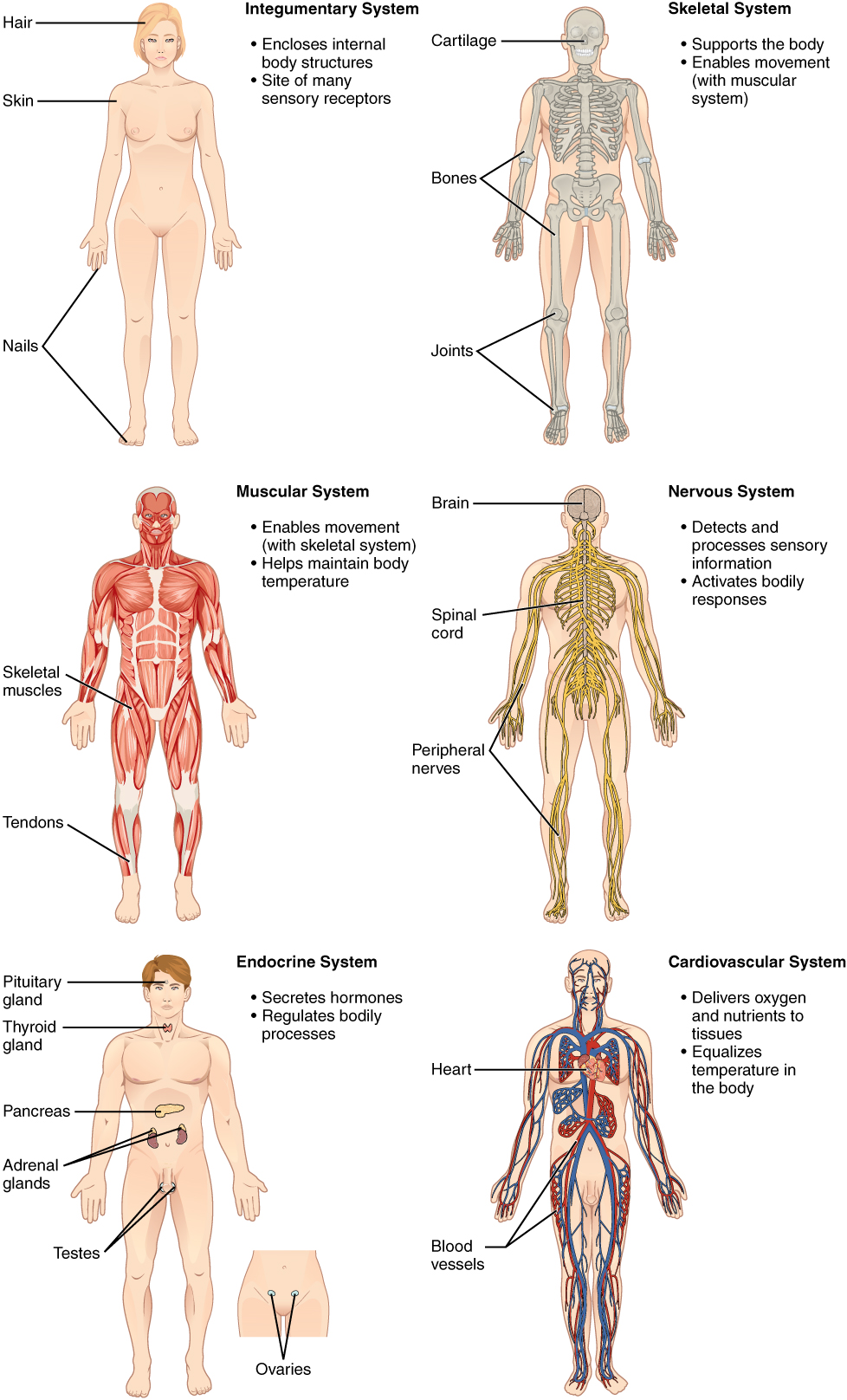
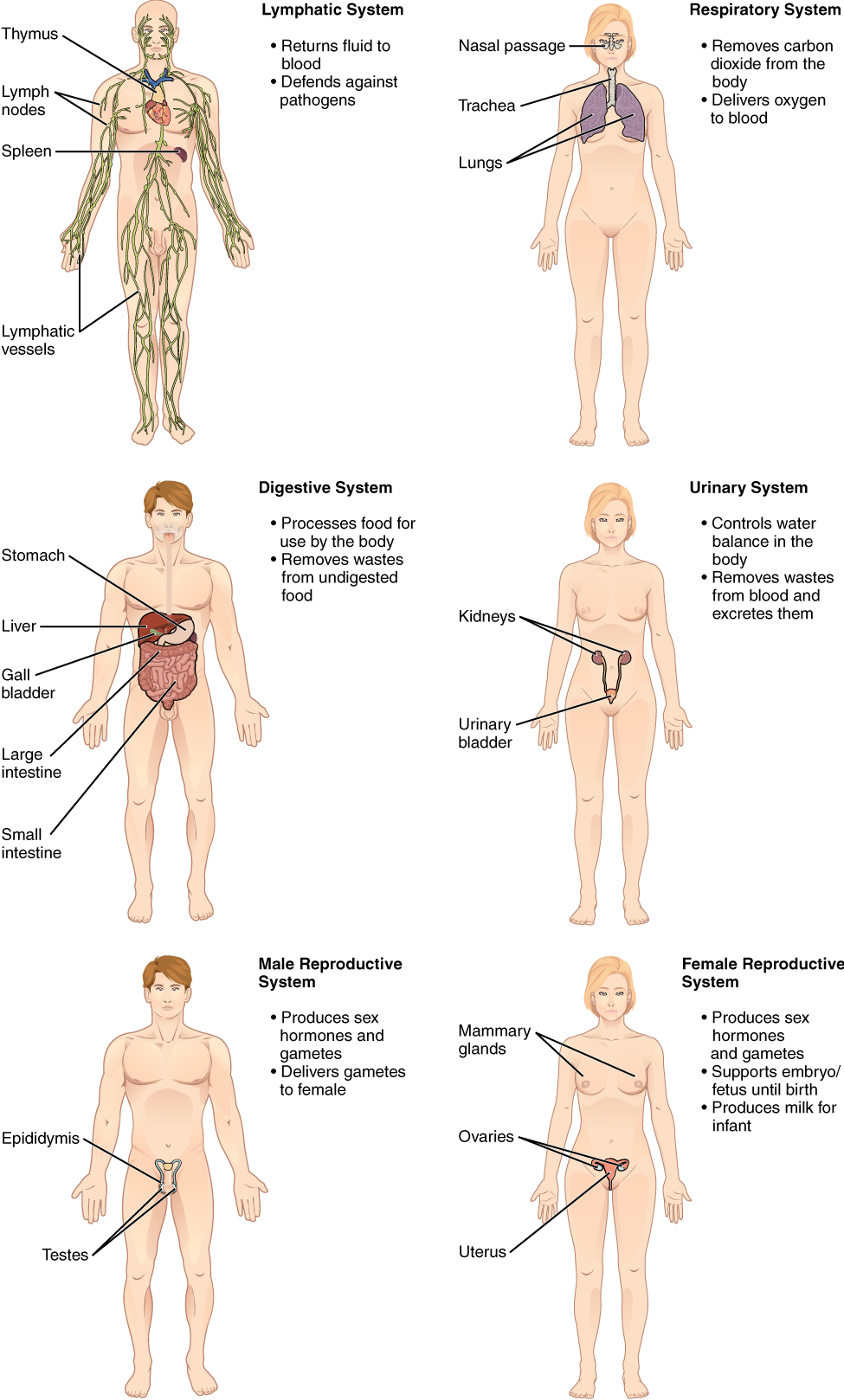
Anatomical Terminology
Anatomical Position
Anatomists and health care providers use terminology for the purpose of precision and to reduce medical errors. For example, is a scar “above the wrist” located on the forearm two or three inches away from the hand? Or is it at the base of the hand? Is it on the palm-side or back-side? By using precise anatomical terminology, we eliminate ambiguity. Anatomical terms derive from ancient Greek and Latin words.
To further increase precision, anatomists standardize the way in which they view the body. Just as maps are normally oriented with north at the top, the standard body “map,” or anatomical position, is that of the body standing upright, with the feet at shoulder width and parallel, toes forward. The upper limbs are held out to each side, and the palms of the hands face forward (see Figure 1.4).
Using this standard position reduces confusion. It does not matter how the body being described is oriented, the terms are used as if it is in anatomical position. For example, a scar in the “anterior (front) carpal (wrist) region” would be present on the palm side of the wrist. The term “anterior” would be used even if the hand were palm down on a table.
A body that is lying down is described as either prone (face down) or supine (face up). These terms are sometimes used in describing the position of the body during specific physical examinations or surgical procedures.
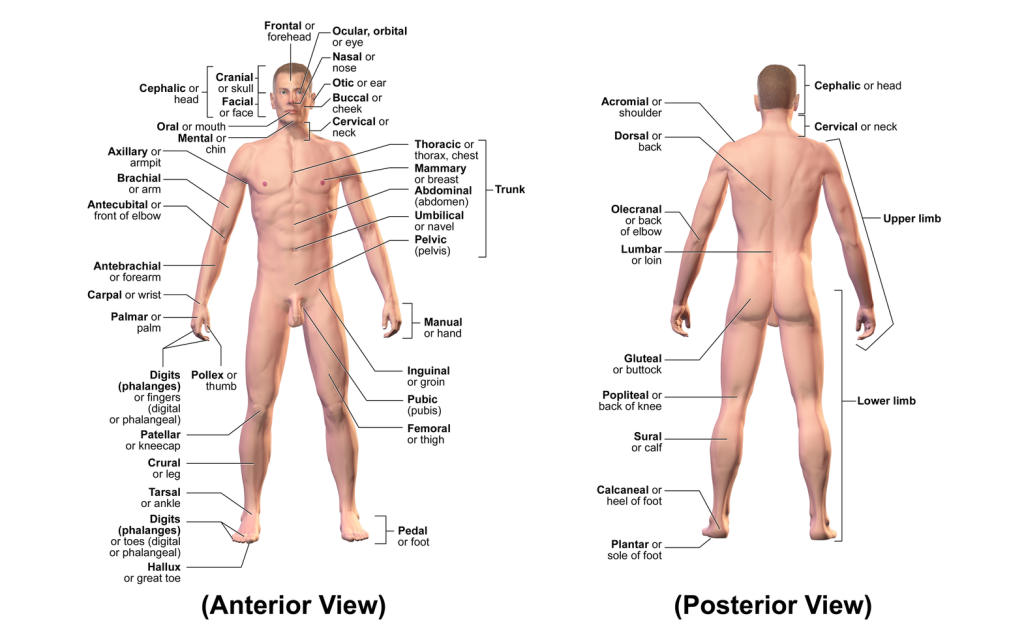
Regional Terms
The human body’s numerous regions have specific terms to help increase precision. Notice that the term “brachial” or “arm” is reserved for the “upper arm” and “antebrachial” or “forearm” is used rather than “lower arm.” Similarly, “femoral” or “thigh” is correct, and “leg” or “crural” is reserved for the portion of the lower limb between the knee and the ankle. The commonly used regional terms are in Figure 1.4. It is also helpful to learn anatomical regions because often the names of structures are based on the region they are found in (e.g., brachial artery, cervical vertebrae, gluteus maximus, femur bone, etc.).
Directional Terms
Directional terms are essential for describing the relative locations of different body structures. For instance, an anatomist might describe one band of tissue as “inferior to” another or a physician might describe a tumor as “superficial to” a deeper body structure. Commit these terms to memory to avoid confusion when you are studying or describing the locations of particular body parts (Figure 1.5).
- Anterior (or ventral) describes the front or direction toward the front of the body. The toes are anterior to the foot.
- Posterior (or dorsal) describes the back or direction toward the back of the body. The popliteus is posterior to the patella.
- Superior (or cranial) describes a position above or higher than another part of the body proper. The orbits are superior to the oris.
- Inferior (or caudal) describes a position below or lower than another part of the body proper; near or toward the tail (in humans, the coccyx, or lowest part of the spinal column). The pelvis is inferior to the abdomen.
- Lateral describes the side or direction toward the side of the body. The thumb (pollex) is lateral to the digits.
- Medial describes the middle or direction toward the middle of the body. The hallux is the medial toe.
- Proximal describes a position in a limb that is nearer to the point of attachment or the trunk of the body. The brachium is proximal to the antebrachium.
- Distal describes a position in a limb that is farther from the point of attachment or the trunk of the body. The crus is distal to the femur.
- Superficial describes a position closer to the surface of the body. The skin is superficial to the bones.
- Deep describes a position farther from the surface of the body. The brain is deep to the skull.
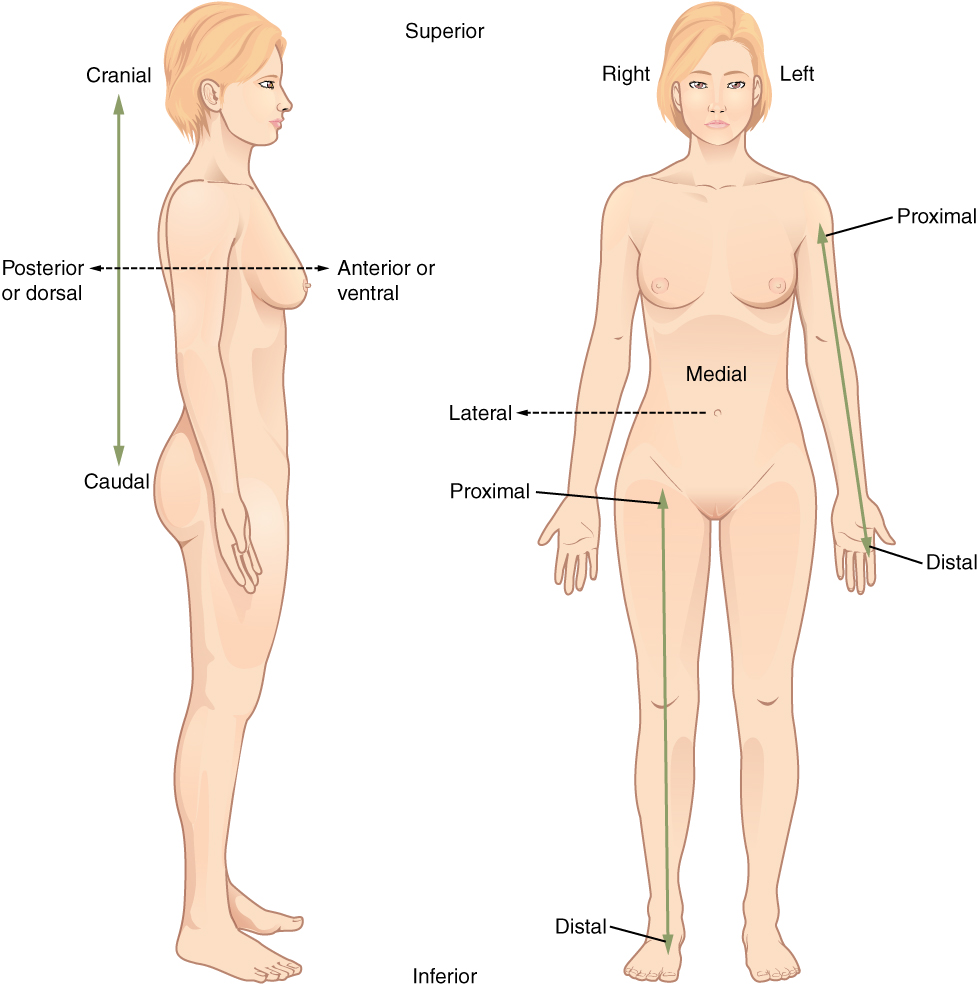
Body Planes
A section is a two-dimensional surface of a three-dimensional structure that has been cut. Modern medical imaging devices enable clinicians to obtain “virtual sections” of living bodies. We call these scans. Body sections and scans can be correctly interpreted, however, only if the viewer understands the plane along which the section was made. A plane is an imaginary two-dimensional surface that passes through the body. There are three planes commonly referred to in anatomy and medicine (Figure 1.6):
- The sagittal plane is the plane that divides the body or an organ vertically into right and left sides. If this vertical plane runs directly down the middle of the body, it is called the midsagittal or median plane. If it divides the body into unequal right and left sides, it is called a parasagittal plane or less commonly a longitudinal section.
- The frontal plane is the plane that divides the body or an organ into an anterior (front) portion and a posterior (rear) portion. The frontal plane is often referred to as a coronal plane. (“Corona” is Latin for “crown.”)
- The transverse plane is the plane that divides the body or organ horizontally into upper and lower portions. Transverse planes produce images referred to as cross sections.
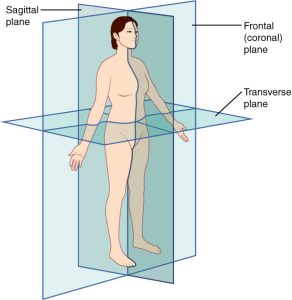
Body Cavities and Serous Membranes
The body maintains its internal organization by means of membranes, sheaths, and other structures that separate compartments. The dorsal (posterior) cavity and the ventral (anterior) cavity are the largest body compartments (Figure 1.7). These cavities contain and protect delicate internal organs, and the ventral cavity allows for significant changes in the size and shape of the organs as they perform their functions. The lungs, heart, stomach, and intestines, for example, can expand and contract without distorting other tissues or disrupting the activity of nearby organs.
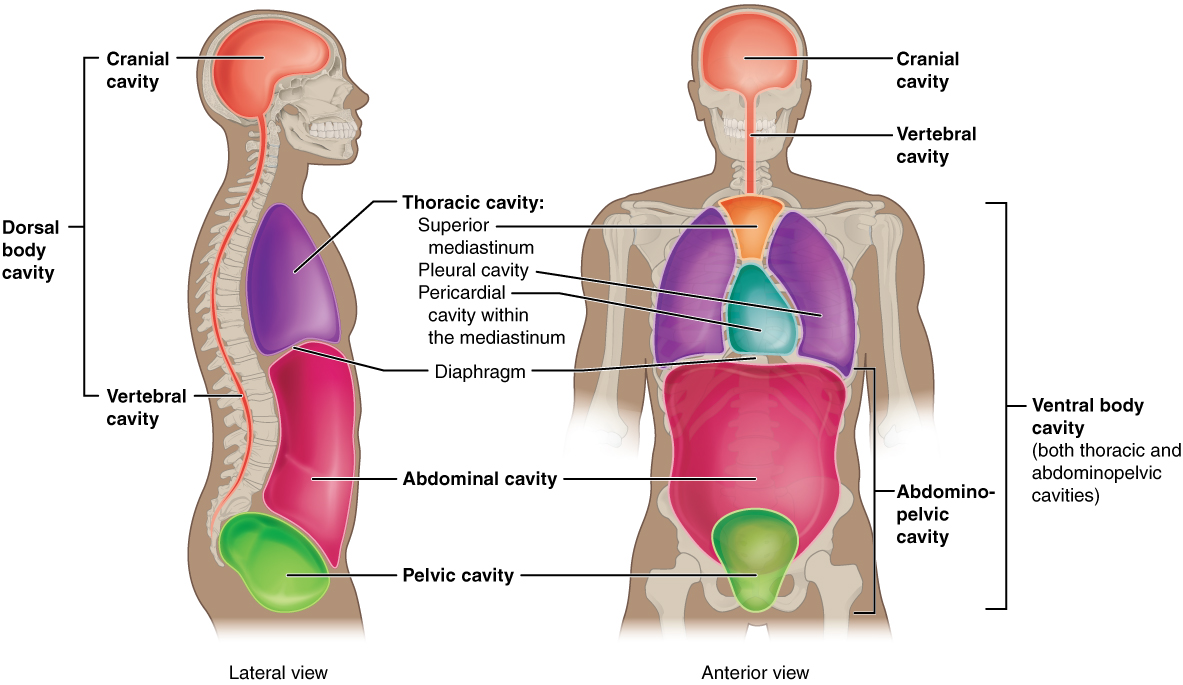
Subdivisions of the Posterior (Dorsal) and Anterior (Ventral) Cavities
The posterior (dorsal) and anterior (ventral) cavities are each subdivided into smaller cavities.
The posterior (dorsal) cavity has two main subdivisions:
- In the posterior (dorsal) cavity, the cranial cavity houses the brain
- Protected by the bones of the skulls and cerebrospinal fluid
- The spinal cavity (or vertebral cavity) encloses the spinal cord.
- Protected by the vertebral column and cerebrospinal fluid
The anterior (ventral) cavity has two main subdivisions:
- The thoracic cavity is the more superior subdivision of the anterior cavity, and it is enclosed by the rib cage. The diaphragm forms the floor of the thoracic cavity and separates it from the more inferior abdominopelvic cavity. Within the thoracic cavity there are smaller cavities:
- The right and left pleural cavities contain the right and left lungs, respectively.
- The mediastinum is medial to the pleural cavities and contains the heart, major blood vessels going to and from the heart, trachea, espophagus, and thymus.
- The pericardial cavity is found within the mediastinum and surrounds the heart.
- The abdominopelvic cavity is inferior to the thoracic cavity and houses the digestive organs, the pelvic cavity, and the reproductive organs. It is the largest cavity in the body. While no membrane physically divides the abdominopelvic cavity, it can still be helpful to divide it into two cavities:
- the abdominal cavity is between the diaphragm and superior border of the hip bones. It contains most of the digestive organs, along with the kidneys and ureters of the urinary system.
- the pelvic cavity is inferior to the abdominal cavity. It contains the internal reproductive organs, along with the urinary bladder and urethra of the urinary system.
Tissue Membranes

- the parietal layer lines the walls of the body cavity
- the visceral layer covers the organs (the viscera)
- the serous cavity is a thin, fluid-filled space between the parietal and visceral layers

The fluid in serous cavities is called serous fluid. Serous fluid provides protection to the organs by reducing friction as the organs move against other organs and the walls of the cavities. There are three serous membranes found in the ventral cavity:
- Pleura: surrounds the lungs in the pleural cavity and reduces friction between the lungs and the body wall.
- Pericardium: surrounds the heart in the pericardial cavity and reduces friction between the heart and the wall of the pericardium.
- Peritoneum: surrounds several organs in the abdominopelvic cavity. The peritoneal cavity reduces friction between the abdominal and pelvic organs and the body wall.
Abdominal Regions and Quadrants
To promote clear communication, for instance about the location of a patient’s abdominal pain or a suspicious mass, health care providers typically divide up the cavity into either nine regions or four quadrants (Figure 1.10). The more detailed regional approach subdivides the cavity with one horizontal line immediately inferior to the ribs and one immediately superior to the pelvis, and two vertical lines drawn as if dropped from the midpoint of each clavicle (collarbone). There are nine resulting regions. The simpler quadrants approach, which is more commonly used in medicine, subdivides the cavity with one horizontal and one vertical line that intersect at the patient’s umbilicus (navel).
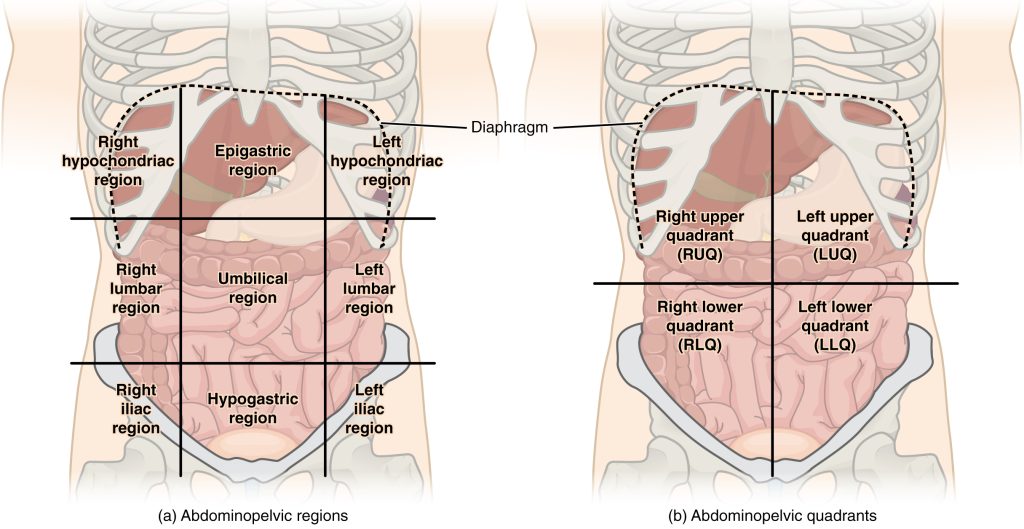
Unless otherwise indicated, this chapter contains material adapted from Anatomy, Physiology, and Medical Language by NSCC, Kimberlee Carter, Marie Rutherford, and Douglas College Biology Department as well as Anatomy and Physiology (on OpenStax), by Betts, et al. and is used under a a CC BY 4.0 international license. Download and access OpenStax Anatomy and Physiology for free at https://openstax.org/books/anatomy-and-physiology/pages/1-introduction.

